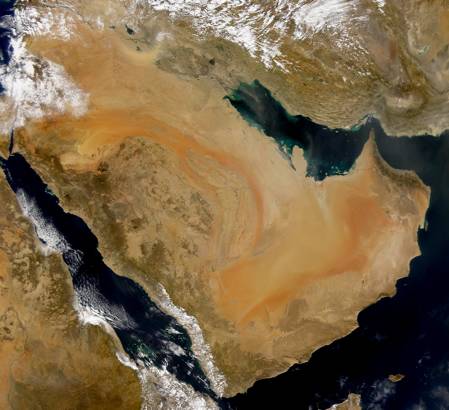Lost Civilization beneath the Persian Gulf Confirms Genesis History of Humanity
In almost every culture and religion of the world lies a story of a lost civilization. The Greeks told the tale of a sophisticated island nation suddenly submerged. However, the Greeks were not the only people group to embrace an Atlantis-type legend; many cultures recounted the lost-city-beneath-the-sea scenario. The ubiquitous nature of these stories, accounts, and legends lends credence to the possibility that in the early days of humanity’s history a relatively advanced civilization was indeed lost.
Now, a research paper published in Current Anthropology provides scientific evidence for such a lost ancient civilization, evidence that confirms much of Genesis 1–11’s historical account of humanity’s early days.1 University of Birmingham archeologist Jeffrey Rose reports on the discovery, conducted over the past six years, of over sixty new archeological sites along the shoreline of the Persian Gulf. All of these sites are dated as older than 75,000 years. Rose states that “these settlements boast well-built permanent stone houses, long-distance trade networks, elaborately decorated pottery, domesticated animals, and even evidence for one of the oldest boats in the world.”2 In 2006, archeologist Hans-Peter Uerpmann of the University of Tubingen in Germany uncovered the remains of three different settlements that date between 25,000 and 125,000 years old at the base of Jebel Faya in the United Arab Emirates.
In his paper, Rose points out that during the late Pleistocene epoch (150,000 to 12,000 years ago) reduced sea levels periodically exposed the “Gulf Oasis.” The Persian Gulf receded to such a degree as to bring above the surface a landmass as large as, or larger than, Great Britain. Rose explains that this landmass was well watered by four large rivers flowing at the time: the Tigris, Euphrates, Karun, and Wadi Batin. Additionally, the region was watered by fresh water springs supplied by subterranean aquifers flowing beneath the Arabian subcontinent. Such an abundant and well-distributed supply of fresh water combined with the region’s warm weather would have supported a lush agricultural enterprise.
Rose argues that during the latter part of the last ice age a thriving civilization existed in what is now the Persian Gulf. As sea levels rose and as water rushed in through the Strait of Hormuz to fill up the Persian Gulf (see figure 1), people would have exited the Gulf Oasis and formed settlements along the rising shoreline. To build an iron-clad case for his theory, Rose calls for underwater exploration in the Persian Gulf to search for tools, human-built structures, and, best of all, fossil remains of humans. However, Rose also points out that the water’s rushing in to fill up the Persian Gulf and other neighboring regions could explain the many flood accounts and myths that emanate from that part of the globe. Such a flood event could have destroyed the very kind of evidence that Rose needs to solidify his case.

Much of what is now the Persian Gulf and the Red Sea was dry during the latter part of the last ice age.
Image credit: NASA/SeaWIFS
Rose’s theory fits not only the biblical account of Noah’s flood, it comports especially well with the earlier chapters of Genesis. Skeptics have long charged that the Bible’s description of the Garden of Eden brings biblical inspiration and inerrancy into question. Genesis 2 claims that the Pishon, Gihon, Tigris, and Euphrates Rivers all meet together in Eden.3 However, the Pishon and Gihon flow out from the mountains of central Arabia (Havilah) and southwest Arabia (Cush), respectively, while the Tigris and Euphrates flow out from the mountains of Ararat in Armenia and Turkey (see figure 1).
As skeptics point out, nowhere on the planet do the four rivers come together. Their charge holds true—but only for today’s geography. All four rivers flow into different parts of the Persian Gulf and all four rivers meet together in what Rose identifies as the Gulf Oasis. As Rose points out, the Gulf Oasis was also watered by springs upwelling from subterranean aquifers. Genesis 2:6 also states that “streams came up from the earth and watered the whole surface of the ground.” Genesis 7:11 identifies “springs of the great deep” as part of the source of the flood waters that wreaked havoc upon the ungodly of Noah’s generation. The Gulf Oasis vindicates the unique claims Genesis makes about the Garden of Eden and its surroundings.
A calibration of the Genesis 5 and 11 genealogies yields dates for Noah and Adam that are consistent with the timing of the existence of the Gulf Oasis. I describe that calibration based on historical and scientific dates for Abraham and Peleg in my book More Than a Theory.4
As Rose himself describes, the Gulf Oasis is consistent with biblical account of Noah’s flood. A long torrential rain storm, a tectonic event bursting forth water from subterranean aquifers, water from the Indian Ocean rushing through the Strait of Hormuz, plus a heat wave generating a sudden melt of snow in the surrounding mountains would have caused a devastating flood wiping out all inhabitants in the Gulf Oasis, the Mesopotamian Plain, and many of the regions surrounding Mesopotamia and what is now the Persian Gulf. Such an event would be perfectly consistent with everything Genesis 6–9 says about Noah’s flood.5 Rose’s study provides yet another example of how the more we learn about archeology, the more reasons we gain for concluding that the Bible is the inspired inerrant Word of God.
Endnotes
- Jeffrey I. Rose, “New Light on Human Prehistory in the Arabo-Persian Gulf Oasis,” Current Anthropology 51 (December 2010): 849–83.
- Jeanna Bryner, “Lost Civilization May Have Existed beneath the Persian Gulf,” LiveScience (December 9, 2010), https://www.livescience.com/history/lost-civilization-possibly-existed-beneath-persian-gulf-101209.html (accessed December 10, 2010).
- Genesis 2:10–14.
- Hugh Ross, More Than a Theory (Grand Rapids: Baker, 2009), 189–90.
- Hugh Ross, The Genesis Question, 2nd ed. (Colorado Springs: NavPress, 2001), 127–72.






